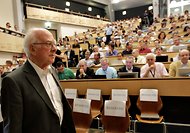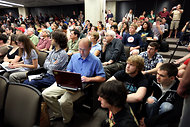ASPEN, Colo. — Physicists working at CERN’s Large Hadron Collidersaid Wednesday that they had discovered a new subatomic particle that looks for all the world like the Higgs boson, a potential key to understanding why elementary particles have mass and indeed to the existence of diversity and life in the universe.
CERNのオーデトリウムで発表された。
座席をとるために、徹夜で列ができたというのは、歴史上、これがはじめただろう。
どうじにアメリカのFermilab
でも同様の発見がなされたとの発表があった。
アメリカでは多少控えめな発表であった。
この理論の提唱者はイギリス人のピーターヒッグズ博士で
CERNの発表で会場に入場するときには
スタンデイング オベーションでむかえられた。
博士は涙ぐんでいた。
ヨーロッパでの反響は以下を読んで欲しい。
(以下、英語の勉強です。長いです)
A New Particle Could Be Physics’ Holy Grail
By DENNIS OVERBYE
Published: July 4, 2012
Fabrice Coffrini/Agence France-Presse — Getty Images
Joe Incandela, a CERN spokesman, right, gestured next to Rolf-Dieter Heuer, CERN's director general, during a press conference at the organization's offices near Geneva on Wednesday.
Related
The Lede Blog: What in the World Is a Higgs Boson? (July 4, 2012)
Pool photo by Denis Balibouse
The British physicist Peter Higgs arrived at CERN's headquarters on Wednesday.
Peter Wynn Thompson for The New York Times
Scientists gathered at Fermilab in Batavia, Ill., to listen to CERN's announcement early Wednesday.
“I think we have it,” said Rolf Heuer, the director general of CERN, in an interview from his office outside of Geneva, calling the discovery “a historic milestone.” His words signaled what is probably the beginning of the end for one of the longest, most expensive searches in the history of science. If scientists are lucky, the discovery could lead to a new understanding of how the universe began.
Dr. Heuer and others said that it was too soon to know for sure whether the new particle, which weighs in at 125 billion electron volts, one of the heaviest subatomic particles yet, fits the simplest description given by the Standard Model, the theory that has ruled physics for the last half century, or whether it is an imposter, a single particle or even the first of many particles yet to be discovered . The latter possibilities are particularly exciting to physicists since they could point the way to new deeper ideas, beyond the Standard Model, about the nature of reality. For now, some physicists are calling it a “Higgs-like” particle.
“It’s great to discover a new particle but you have find out what its properties are,” said John Ellis, a theorist at CERN, the European Organization for Nuclear Research.
Joe Incandela, of the University of California, Santa Barbara, and spokesperson for one of two groups reporting data on Wednesday called the discovery, “very, very significant.It’s something that may, in the end, be one of the biggest observations of any new phenomena in our field in the last 30 or 40 years, going way back to the discovery of quarks, for example.”
Here at the Aspen Center for Physics, a retreat for scientists that will celebrate its 50th birthday on Saturday, the sounds of cheers and popping corks reverberated early Wednesday morning against the Sawatch Range through the Roaring Fork valley of the Rockies, as bleary-eyed physicists watched their colleagues read off the results in a Webcast from CERN. It was a scene duplicated in Melbourne, Australia, where physicists had gathered for a major conference, as well as in Los Angeles, Chicago, Princeton, New York, London, and beyond — everywhere that members of a curious species have dedicated their lives and fortunes to the search for their origins in a dark universe.



